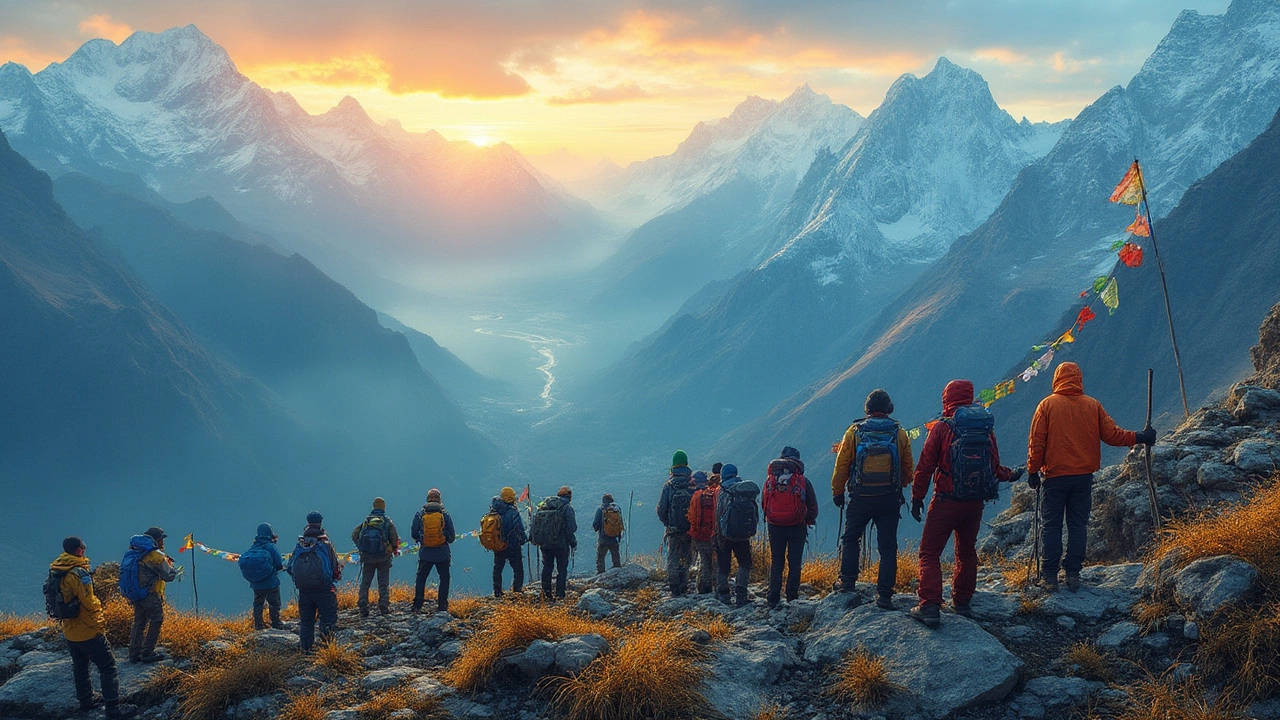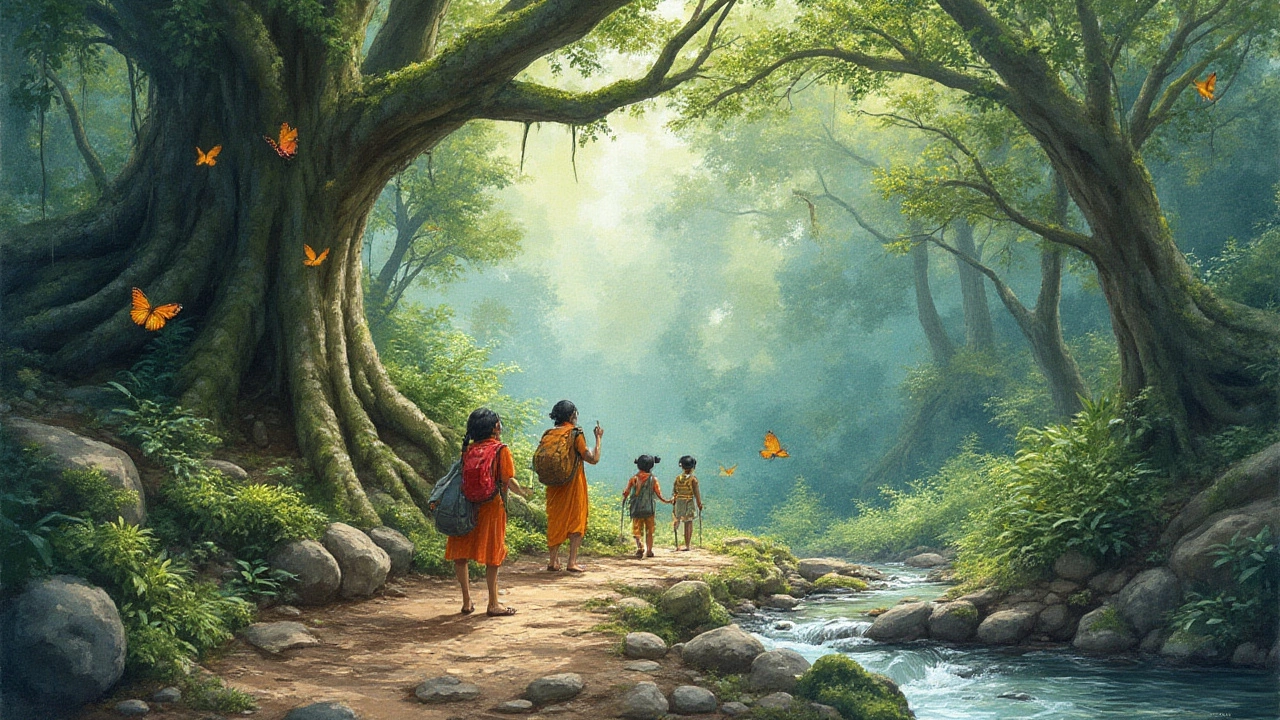Best Trekking Destinations Around the World: Top Places for Adventure Seekers

- Jul, 19 2025
- 0 Comments
- Aaron Blackwood
Mountains don’t care about trends, and they honestly couldn’t give a toss about your Instagram followers either. But here’s the wild thing—one single trail, under the right circumstances, can change what you want from life. Trekking isn’t just a holiday; it’s like swapping your soul’s batteries. People have quit jobs, fallen in love, healed heartbreaks, or straight-up discovered who they are—all because they laced up their boots and vanished into a landscape that doesn’t lie.
But which trek actually earns the title of the best in the world? You hear folks argue fiercely about this stuff over beers in hostel common rooms from New Zealand to Nepal. Some swear by the snowy drama of the Himalayas. Others are obsessed with the raw wind and silence of Patagonia. You even get people who claim their muddy backyard trail is unbeatable. But if you strip away home bias and really try to stack up beauty, challenge, culture, unique vibe, and pure adventure, there’s one route that keeps punching above its weight year after year.
Everest Base Camp. Yeah, it’s famous, maybe too famous—but before you write it off as just another tourist treadmill, ask yourself why legends, adventurers, and first-timers alike fly across the world for this one. The statistics are mind-boggling: about 40,000 trekkers attempt this beast every year. The views? Outrageous. Local stories? Lifelong. The sense of achievement at the finish? Nearly unbeatable. Still, it’s not the only heavyweight challenger, and a few unexpected contenders have been closing in on the crown. So, if you’re planning your next serious walk—or just daydreaming about going off-grid—let’s lay out what actually makes a trekking place the world’s best and how different destinations stack up.
Why Everest Base Camp Continues to Top the List
Ask anyone who’s stood beneath the thunderous face of Mount Everest and they’ll tell you: there’s magic in those thin, freezing air currents. Trekking to Everest Base Camp (EBC) isn’t just an epic walk—it’s an assault on your expectations. Not only do you wind through legendary Sherpa villages and past ancient Buddhist monasteries festooned in prayer flags, but every step hammers home how tiny and human you are in a landscape that’s carved by the gods. EBC sits at a ridiculous 5,364 meters (17,598 feet) above sea level, and just getting there is enough to earn lifelong bragging rights.
Here’s the twist: the Everest Base Camp trek isn’t actually an expedition for expert mountaineers. The standard trek takes about 12 to 16 days, depending on whether you fly straight out or linger for a side adventure (like climbing Kala Patthar for sunrise views over Everest itself, sitting at 5,545m). The biggest challenge isn’t technical skill, but the altitude. About 20% of trekkers struggle with some form of altitude sickness, and going slow with acclimatization days is the single smartest way to avoid disaster. If you’re decent at hiking eight to ten hours a day, and you’ve got a bit of determination, it’s within reach—even if you’re not exactly Bear Grylls.
What about the crowds? Sure, this path gets busy, especially in spring (March to May) and autumn (September to November). But here’s the secret: the sense of camaraderie on this trail turns strangers into instant friends, whether you’re sharing a thermos of tea in Namche Bazaar or gasping your way up the final slope to Base Camp. And honestly, is it surprising that so many people want to see the world’s highest peak up close?
| Fact | Detail |
|---|---|
| Average days to trek EBC | 12-16 days |
| Starting point | Lukla (flight from Kathmandu) |
| Elevation at Base Camp | 5,364 meters (17,598 feet) |
| Trekkers per year | Approx. 40,000 |
| Getting there | 45-minute scenic flight from Kathmandu |
| Best seasons | March-May, September-November |
Still not convinced it’s worth the hassle? Here’s a pro tip: if you can, add on a trip to Gokyo Lakes after EBC. These turquoise glacial lakes, surrounded by untouched snowfields and with far fewer fellow trekkers, will flip your understanding of what Nepal offers beyond Everest. Or take a detour into tiny, windswept Thame, birthplace of Tenzing Norgay, to see a piece of mountaineering history that most trekkers Miss.
The Fierce Competition: Other Legendary Trekking Places
While Everest Base Camp keeps cropping up in every ‘top treks’ list, the world’s packed with alternate legends—and some are much wilder or more remote, giving die-hards plenty of ammo for the ‘best trekking place’ debate. Patagonia’s Torres del Paine Circuit in Chile hits hard, for one: think teeth-like granite peaks, glacial rivers so blue you’d swear someone photoshopped them, and condors wheeling overhead. The full circuit clocks in at almost 130 kilometers, taking 7–10 days of real-deal wilderness walking, often in unruly weather. Patagonia’s upside? Rugged drama with raw, unpredictable conditions that make every day an adventure. Downside? You’ve got to carry basically everything, unless you sign up for one of the pricier, supported trips.
There’s also the Inca Trail in Peru, sliding through high Andean passes to the ancient citadel of Machu Picchu—four days of mist, jungle, and crumbling Inca stonework. Only 500 permits are issued daily (including guides and porters), so you need to book months ahead. But walking through the Sun Gate with the first morning light? That’s the stuff of travel legend, and it explains why these permits vanish so quickly every year.
The USA cranks out some world-class trails, too—think the John Muir Trail (338km through California’s Sierra Nevada), or the Appalachian Trail for the truly ambitious (3,524km from Georgia to Maine). Both offer huge variety: alpine meadows, granite domes, black bears, and some of the best wilderness camping in the world. The Tour du Mont Blanc is Europe’s classic loop, linking France, Italy, and Switzerland over 170km. Glaciers, cheese-laden refuges, and flower-strewn valleys? Yes, please.
Then there’s the wild card: New Zealand’s Te Araroa, nearly 3,000 kilometers of crisscrossing coast, forest, farmland, and alpine passes—truly epic. Fewer folks tackle the whole thing, but sections like Tongariro Crossing deliver Hollywood backdrops with every step. If you want a blend of wilderness and creature comforts, New Zealand’s Great Walks system is second to none: well-marked, stunning, and safe for solo explorers. The downside? It’s so good that huts book up fast, so planning ahead is non-negotiable.
- Everest Base Camp, Nepal: Legendary Himalayan adventure with Sherpa culture, epic vistas, and Base Camp at 5,364 meters.
- Torres del Paine, Chile: Wild Patagonian winds, valleys, towering granite, and true remoteness.
- Inca Trail, Peru: Ancient stones, cloud forest, and the ultimate reward of Machu Picchu’s sunrise.
- John Muir Trail, USA: Long, wild, and filled with mountain passes and high lakes.
- Tour du Mont Blanc, Europe: Alpine charm, three cultures, jaw-dropping scenery, and comfort stops along the way.
- Te Araroa, New Zealand: Wild variety from city escapes to mountain solitude.

Hidden Gems: Off-the-Beaten-Path Adventures
Mega-famous treks get most of the limelight, but some genuine treasures never show up in glossy travel magazines. The Markha Valley in India’s Ladakh region is extraordinary, threading between candy-colored cliffs and timeless Buddhist villages—with almost no crowds, even at peak trekking season. Bonus: you’ll often spot blue sheep or even a wild ibex scrambling across those lunar hillsides. Accommodation is dirt simple, but you get world-class starfields every night.
You want utter solitude and a hit of desert mystery? Jordan’s Dana to Petra trek takes you through the crumpled red canyons of the Dana Biosphere Reserve, across sand fields and scrubby plateaus, ending with a jaw-dropping arrival at the lost city of Petra. With only a trickle of trekkers sharing the route, you decide your own pace—and you’ll have the ancient tombs to yourself at sunrise.
Japan’s Kumano Kodo, nearly 1200 years old, meanders through cool forests and hidden shrines, perfect for introspective hikes. Albania—a wildcard for most—offers the ‘Peaks of the Balkans’ trail through nearly untouched alpine meadows and remote mountain huts, all with hospitality you’d never expect at the end of a hard day’s climb.
Looking for something that blends hard hiking with deep immersion into living culture? Mount Rinjani on Indonesia’s Lombok island offers a volcanic crater rim (and, yes, a brutal climb), but you camp under the open sky and share fireside meals with Sasak villagers along the way. Want wildlife? Head for Uganda’s Rwenzori Mountains, where glaciers slide right above equatorial jungle, and you might cross paths with chattering monkeys one minute and snowy peaks the next.
The bottom line: the best trek for you might not be the world’s most famous one. Sometimes the right trail is the one that lets you disconnect, listen to your own mind, and fill your camera roll with things even Google hasn’t seen yet.
How to Choose Your Perfect Trek and Make It Unforgettable
Let’s get real for a second—the best trekking place in the world isn’t the same for everyone. Some people live for brutal altitudes and scree-strewn passes; others want gentle slopes and hot meals at the end of each day. Your perfect trek comes down to a few brutally honest questions: What level of fitness are you rocking? Do you want a challenge, or more of a meditative walk? Are you cool with basic huts, or would you rather camp wild under shooting stars?
Here’s where it pays to know yourself as well as you know your hiking boots. The notorious popularity of Everest Base Camp isn’t just about the mountain; it’s the collision of accessibility, pure Himalayan drama, and the chance to soak up one of the richest mountain cultures on the planet. But if you want to vanish from the crowds, you’ll do better off the classic tourist trails. Look for routes in Mongolia’s Altai, or Italy’s Dolomites outside the tourist months, or Canada’s Great Divide Trail for pure wilderness. Want comfort and company? Trails like Tour du Mont Blanc or New Zealand’s Routeburn offer a balance: you get communal huts and friendly new faces but plenty of solitude too.
Packing smart makes or breaks your trek. Weather can change in seconds, so throw in an extra thermal even when the forecast claims sunshine. Always carry a water filter (even on famous trails—nothing ruins a trip faster than a dodgy stomach), and a simple emergency kit. Check the permit situation way ahead of time—Inca Trail, for example, can book out months in advance. And even city dwellers should get those boots dirty before they leave home—break-in time saves a world of blisters.
- Research your trek’s difficulty and altitude thoroughly. A little honesty here saves a lot of pain later.
- Pick the right season. Monsoon downpours can destroy a trek, so check local conditions with actual humans who’ve done the route recently.
- Get fit—hiking stairs, carrying a loaded backpack, or jogging hills will pay off big-time.
- Sort permits, flights, and insurance as early as you can. Nothing kills excitement like red tape mishaps.
- Pack light but smart—skip what you don’t need, but don't skimp on quality socks, a headlamp, and rain gear.
- Respect local cultures. Learn the greeting in Nepali, Spanish, or Swahili before you fly out. You’ll make friends fast.
- Travel with a sense of humor. Weather goes bad, boots break, blisters happen—but that’s all part of the story.
By the time you’re trudging up that last, cruel switchback—whether you’re bound for Everest, Patagonia, or some hidden path in your own backyard—the best trekking place on earth is wherever the wild feels bigger than you, and you wake up happy for the next sunrise. No map can tell you which trail is right. But trust your gut, do the prep, and when in doubt—just walk. You’ll end up somewhere unforgettable, I promise.